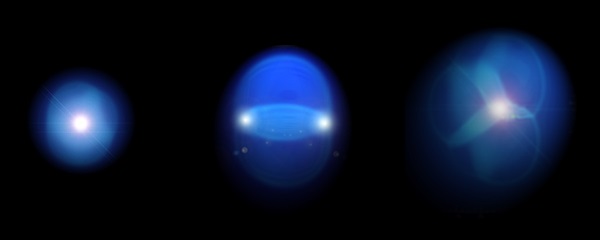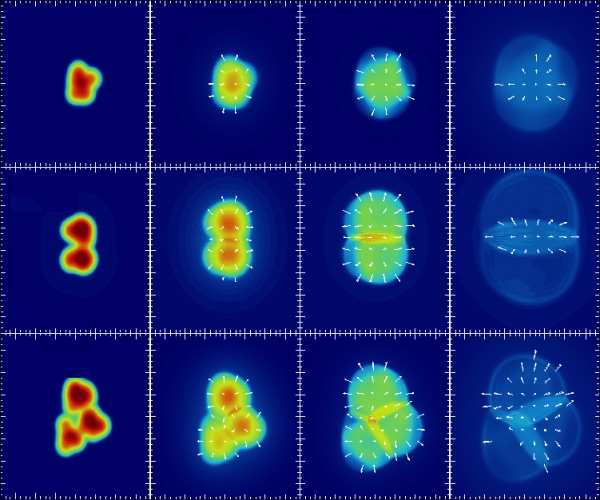Key Takeaways:
By slamming small particles into heavy gold nuclei at nearly the speed of light, scientists have created tiny, ultra-hot droplets of a bizarre type of matter called a quark-gluon plasma (QGP), which once filled the entire universe shortly after the Big Bang.
Creating such a ‘quark soup’ is a tough task in its own right; the first sample of QGP was produced less than two decades ago by smashing two heavy atoms together. But for this new study, which was carried out as part of the PHENIX experiment at Brookhaven National Laboratory, the researchers took it beyond just creating the substance.
They showed it’s possible to create samples of quark soup by simply shooting small particles, such as protons, at heavier nuclei, such as gold. By doing so, the team surprisingly found that the tiny droplets of QGP expanded outward in three distinct geometric shapes — circles, ellipses, and triangles.
Exactly which shape the droplets formed depended on what type of smaller particle was used as the projectile. Shooting the gold with a proton creates a circular pattern; shooting the gold with a deuteron (a proton-neutron pair) creates an elliptical pattern; and shooting the gold with a helium-3 atom (a proton-proton-neutron trio) creates a triangular pattern.
“Imagine that you have two droplets that are expanding into a vacuum,” said co-author Jamie Nagle, a professor of physics at the University of Colorado, Boulder, in a statement. “If the two droplets are really close together, then as they’re expanding out, they run into each other and push against each other, and that’s what creates this pattern.” In other words, the expanding drops of quark soup behave much like idealized ripples in a pond.
WTH is QGP?
There are three very familiar states of matter: solid, liquid, and gas. When something is a solid, its individual molecules have so little energy that they are easily held in place by intermolecular forces. In a liquid, the molecules have more energy, which allows them to slide right past each other (though they still notice the intermolecular forces, which leads to viscosity). In a gas, the molecules have a whole bunch of energy, so they zip right by each other without hardly batting an eye.
Then there’s plasma, the fourth fundamental state of matter. Plasmas come into existence when a gas cloud has so much energy that electrons are stripped away from the nuclei within the cloud. With so many electrons roaming free, plasmas are extremely electrically conductive. Although plasmas are not as common on Earth as the standard trifecta of states, we do see plasmas during certain events like aurorae or lightning storms.
But there’s one more state of matter that is both the rarest and the most bizarre, at least in the present-day universe. That state is a quark-gluon plasma.
For just a few thousandths of a second after the Big Bang, the universe was so hot and so dense that atoms could not form at all. Instead, space was exclusively filled with quark-gluon plasma, or quark soup. This odd form of matter can only exist when temperatures (in a scientific sense, meaning the average kinetic energy of particles) reach several trillion degrees, or roughly 250,000 times hotter than the center of the Sun.
Because scientists are extremely interested in learning about the earliest moments of the universe, understanding how quark-gluon plasmas behave is paramount to our understanding of the cosmos itself.
The new research not only provides further proof that scientists can truly create a melted soup of quarks and gluons, which both serve as building blocks for protons and neutrons. It also shows that QGPs act very much like perfect fluids, which collectively flow as a coherent unit.
“As recently as five years ago, it would have been heretical to think one can have many-body, collective dynamics in these vanishingly small (femtometer scale or smaller) systems,” said Dennis Perepelitsa, a professor at the University of Colorado, Boulder and collaborator on the project, to Gizmodo. However, this new study suggests that at high enough energies, the tiniest particles in the universe can behave and flow like an idealized, near-frictionless liquid.
“If you could have a bottle of this liquid on your desk, and you were to tip it over and have it flow around an obstacle, it would do so with almost no friction,” said Paul Romatschke, a physics professor at University of Colorado, Boulder and collaborator on the project, in a statement.
What’s next?
Based on this new understanding of quark-gluon plasma, theoretical physicists soon may be able to tease out how the cosmos’ original quark soup cooled over the universe’s first few milliseconds. By doing so, they will have a new method for investigating the birth of the very first atoms, which may provide insight into the cosmos we see today.
Fortunately, the PHENIX experiment will soon receive an upgrade to become sPHENIX, which will be able to probe quark-gluon plasmas at even smaller scales.











